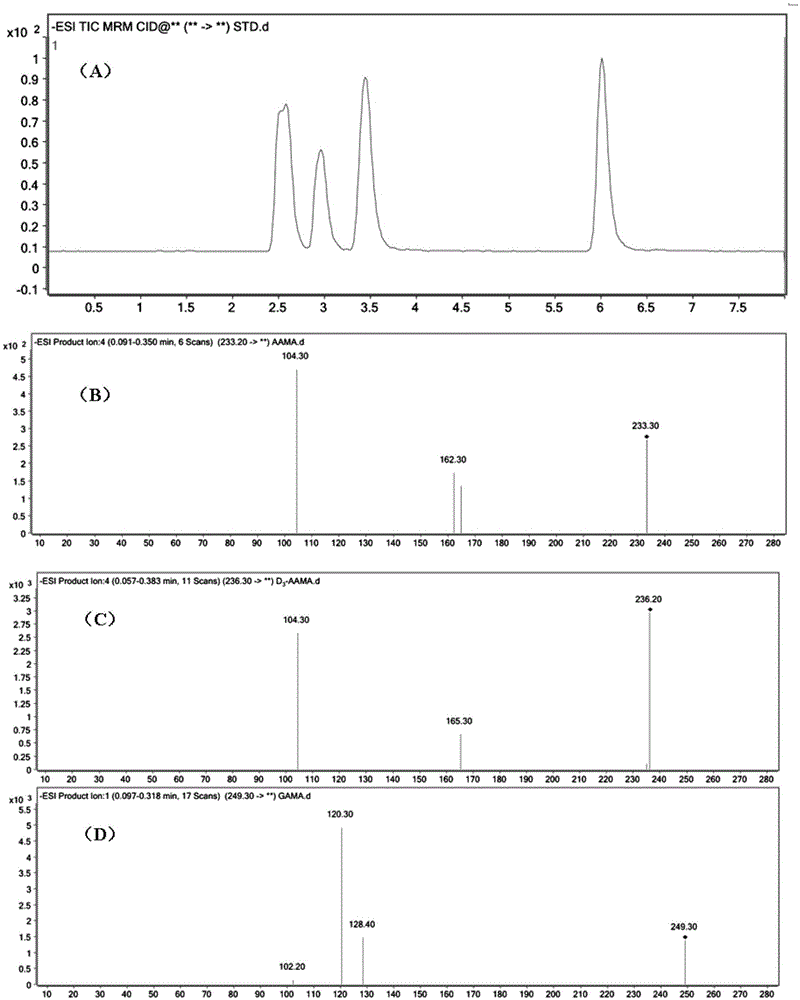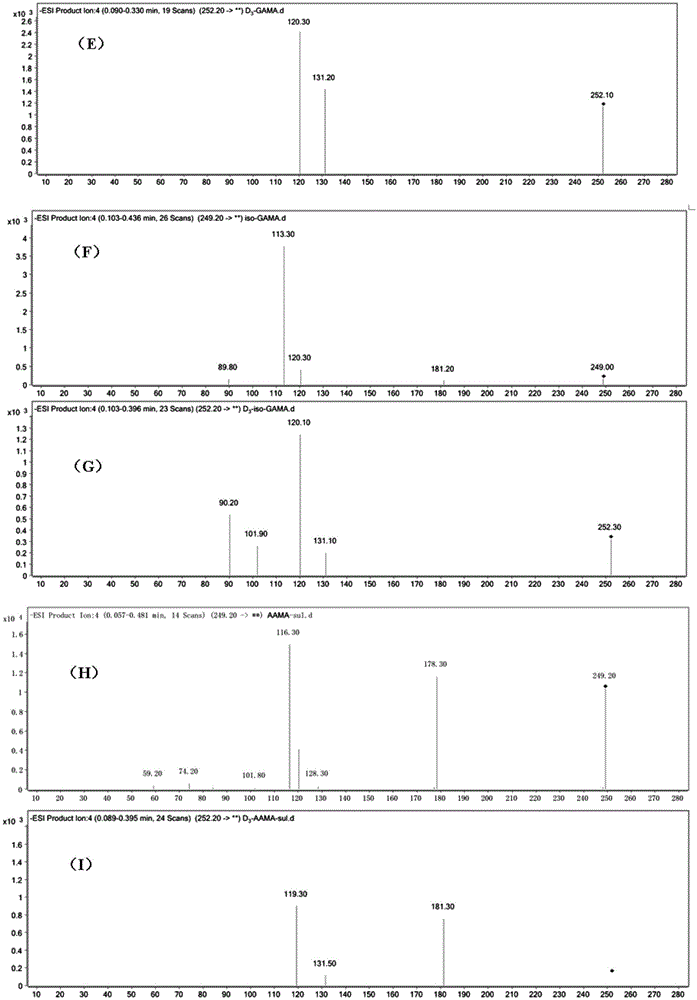Mercapturic acid adduct detection method for evaluating short-term exposure of acrylamide and application
A technology of mercaptouric acid and acrylamide, which is applied in the field of simultaneous detection of mercaptouric acid adducts, can solve the problem of unfavorable large-scale biological sample detection, low-content sample detection, simultaneous quantitative analysis of four mercaptouric acid adducts, and long analysis time. And other issues
- Summary
- Abstract
- Description
- Claims
- Application Information
AI Technical Summary
Problems solved by technology
Method used
Image
Examples
Embodiment 1
[0117] Embodiment 1. A method for synchronous detection of mercaptouric acid adducts for evaluating short-term in vivo exposure of dietary acrylamide. The detection object is rat urine, and the following steps are performed in sequence:
[0118] 1), sample pretreatment:
[0119] Rat urine pretreatment method: Thaw SpragueDawley rat urine, take 10 μL mouse urine, add 10 μL mixed isotope internal standard (D 3 -AAMA,D 3 -GAMA,D 3 -IsoGAMA, the concentration is 10 μg / mL, using the diluent as the solvent), dilute 100 times with the diluent, dilute to 1 mL, vortex for 2 min to mix, filter through a 0.22 μm microporous membrane, and then inject the sample for analysis.
[0120] The diluent is: 0.1% (volume %) formic acid aqueous solution;
[0121] 2), chromatographic conditions:
[0122] Flow rate: 0.2mL / min; column temperature: 40°C.
[0123] Table 3. Gradient elution program of optimized mobile phase
[0124]
[0125] instruction manual:
[0126] A is 0.1% (volume %) for...
Embodiment 2
[0144] Example 2. A method for synchronous detection of mercaptouric acid adducts for evaluating short-term in vivo exposure to dietary acrylamide. The detection object is rat urine, and the following steps are performed in sequence:
[0145] 1), sample pretreatment:
[0146] Rat urine pretreatment method: thaw rat urine, take a certain amount of 5 μL mouse urine, add 10 μL mixed isotope internal standard (D 3 -AAMA,D 3 -GAMA,D 3 -IsoGAMA, the concentration is 10 μg / mL, using the diluent as the solvent), dilute 200 times with the diluent, set the volume to 1 mL, vortex for 2 min to mix, filter through a 0.22 μm microporous membrane, and then inject the sample for analysis.
[0147] The diluent is: 0.5% (volume %) formic acid aqueous solution;
[0148] 2), chromatographic conditions:
[0149] Flow rate: 0.2mL / min; column temperature: 40°C.
[0150] Gradient elution program of mobile phase in Table 5
[0151]
[0152] instruction manual:
[0153] A is 0.5% (volume %) f...
Embodiment 3
[0165] Example 3. A method for synchronous detection of mercaptouric acid adducts for evaluating short-term in vivo exposure to dietary acrylamide. The detection object is human urine, and the following steps are performed in sequence:
[0166] 1), sample pretreatment:
[0167] Thaw human urine, take 1mL, add 20μL mixed isotope internal standard (D 3 -AAMA,D 3 -GAMA,D 3 - Different GAMA, D 3 -AAMA sulfoxide, the concentration is 10 μg / mL, and the diluent is used as the solvent), 10 μL of formic acid and 2 mL of ammonium formate (50 mmol / L, pH 2.5) were added in sequence, vortexed for 30 s, and then centrifuged at 10000 r / min for 5 min. Then load the supernatant to a solid-phase extraction column pre-activated with 3mL of methanol, 1.5mL of water and 1.5mL of 0.1% formic acid in water, rinse with 2mL eluent after draining, remove impurities and discard the eluent solution; finally eluted with 2 mL of 1% formic acid methanol solution (that is, the volume concentration of for...
PUM
 Login to View More
Login to View More Abstract
Description
Claims
Application Information
 Login to View More
Login to View More - R&D
- Intellectual Property
- Life Sciences
- Materials
- Tech Scout
- Unparalleled Data Quality
- Higher Quality Content
- 60% Fewer Hallucinations
Browse by: Latest US Patents, China's latest patents, Technical Efficacy Thesaurus, Application Domain, Technology Topic, Popular Technical Reports.
© 2025 PatSnap. All rights reserved.Legal|Privacy policy|Modern Slavery Act Transparency Statement|Sitemap|About US| Contact US: help@patsnap.com



